Pioneer DEH-14, DEH-1400 User Manual

High power CD player with FM/AM tuner
Syntoniseur FM/AM et lecteur de CD, “Puissance élevée”
Operation Manual
DEH-1400
DEH-14
Mode d’emploi
English
Español Français

Contents
Pioneer product.
instructions so you will know how to oper- finished reading the instructions, put them
Before You Start
Dear Customer 2 About this unit 3 About this manual 3
After-sales service for Pioneer products 3 Precautions 3
Protecting your unit from theft 4
•Removing the front panel 4
•Attaching the front panel 4 What’s what 5
Power ON/OFF
Turning the unit on 6
Selecting a source 6
Turning the unit off 6
Tuner
Listening to the radio 6 Storing and recalling broadcast
frequencies 7
Tuning in strong signals 8 Storing the strongest broadcast
frequencies 8
Built-in CD Player
Playing a CD 8
Playing tracks in a random order 9 Repeating play 9
Pausing CD playback 9
Audio Adjustments
Introduction of audio adjustments 10 Using balance adjustment 10
Using the equalizer 11
•Recalling equalizer curves 11
•Adjusting equalizer curves 11 Adjusting loudness 11
Front image enhancer (FIE) 12 Adjusting source levels 12
Other Functions
Setting the time 13
Setting the time display on or off 13
Additional Information
CD player and care 14 CD-R/CD-RW discs 14
Understanding built-in CD player error messages 15
Specifications 16
1 En
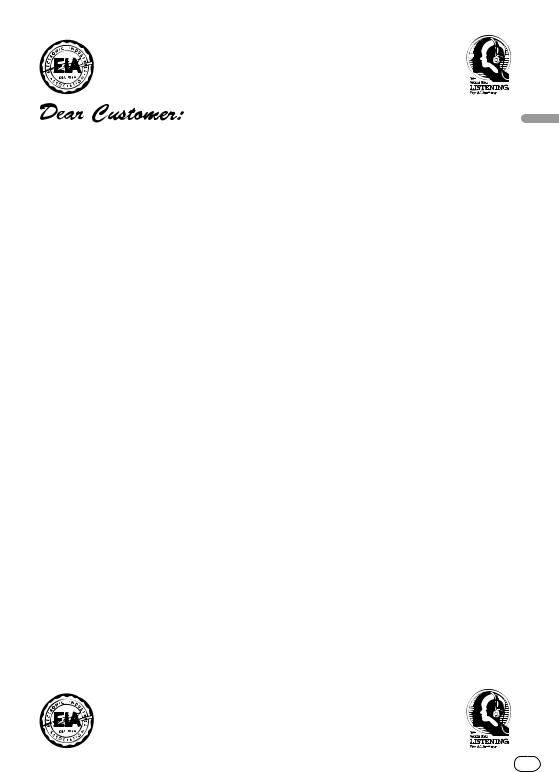
Selecting fine audio equipment such as the unit you’ve just purchased is only the start of your musical enjoyment. Now it’s time to consider how you can maximize the fun and excitement your equipment offers. This manufacturer and the Electronic Industries Association’s Consumer Electronics Group want you to get the most out of your equipment by playing it at a safe level. One that lets the sound come through loud and clear without annoying blaring or distortion—and, most importantly, without affecting your sensitive hearing.
Sound can be deceiving. Over time your hearing “comfort level” adapts to higher volumes of sound. So what sounds “normal” can actually be loud and harmful to your hearing. Guard against this by setting your equipment at a safe level BEFORE your hearing adapts.
To establish a safe level:
•Start your volume control at a low setting.
•Slowly increase the sound until you can hear it comfortably and clearly, and without distortion.
Once you have established a comfortable sound level:
• Set the dial and leave it there.
Taking a minute to do this now will help to prevent hearing damage or loss in the future. After all, we want you listening for a lifetime.
We Want You Listening For A Lifetime
Used wisely, your new sound equipment will provide a lifetime of fun and enjoyment. Since hearing damage from loud noise is often undetectable until it is too late, this manufacturer and the Electronic Industries Association’s Consumer Electronics Group recommend you avoid prolonged exposure to excessive noise. This list of sound levels is included for your protection.
Decibel
Level Example
30 Quiet library, soft whispers
40 Living room, refrigerator, bedroom away from traffic
50 Light traffic, normal conversation, quiet office
60 Air conditioner at 20 feet, sewing machine
70 Vacuum cleaner, hair dryer, noisy restaurant
80 Average city traffic, garbage disposals, alarm clock at two feet.
THE FOLLOWING NOISES CAN BE DANGEROUS UNDER CONSTANT EXPOSURE
90 Subway, motorcycle, truck traffic, lawn mower
100 Garbage truck, chain saw, pneumatic drill
120 Rock band concert in front of speakers, thunderclap
140 Gunshot blast, jet plane
180 Rocket launching pad
Information courtesy of the Deafness Research Foundation.
English
Español
Italiano Français Deutsch
Nederlands
En 2

Before You Start
About this unit
The tuner frequencies on this unit are allocated for use in North America. Use in other areas may result in improper receiption.
 Important
Important
The serial number is located on the top of this unit. For your own security and convenience, be sure to record this number on the enclosed warranty card. 
About this manual
This unit features a number of sophisticated functions ensuring superior reception and operation. All the functions have been designed for the easiest possible use, but many are not selfexplanatory. This operation manual will help you benefit fully from this product’s potential and to maximize your listening enjoyment.
We recommend that you familiarize yourself with the functions and their operation by reading through the manual before you begin using this unit. It is especially important that you read and observe precautions on this page and in other sections. 
After-sales service for Pioneer products
Please contact the dealer or distributor from where you purchased this unit for after-sales service (including warranty conditions) or any other information. In case the necessary information is not available, please contact the companies listed below:
Please do not ship your unit to the companies at the addresses listed below for repair without advance contact.
U.S.A.
Pioneer Electronics Service, Inc. CUSTOMER SERVICE DEPARTMENT P.O. Box 1760
Long Beach, CA 90801 800-421-1404
CANADA
Pioneer Electronics of Canada, Inc. CUSTOMER SATISFACTION DEPARTMENT 300 Allstate Parkway
Markham, Ontario L3R OP2 (905) 479-4411 1-877-283-5901
For warranty information please see the Limited Warranty sheet included with this unit. 
Precautions
CAUTION: USE OF CONTROL OR ADJUSTMENT OR PERFORMANCE OF PROCEDURES OTHER THAN THOSE SPECIFIED HEREIN MAY RESULT IN HAZARDOUS RADIATION EXPOSURE.
CAUTION: THE USE OF OPTICAL INSTRUMENTS WITH THIS PRODUCT WILL INCREASE EYE HAZARD.
•Keep this manual handy as a reference for operating procedures and precautions.
•Always keep the volume low enough so you can hear sounds outside of the car.
•Protect this product from moisture.
•If the battery is disconnected or discharged, the preset memory will be erased and must be reprogrammed. 
3 En
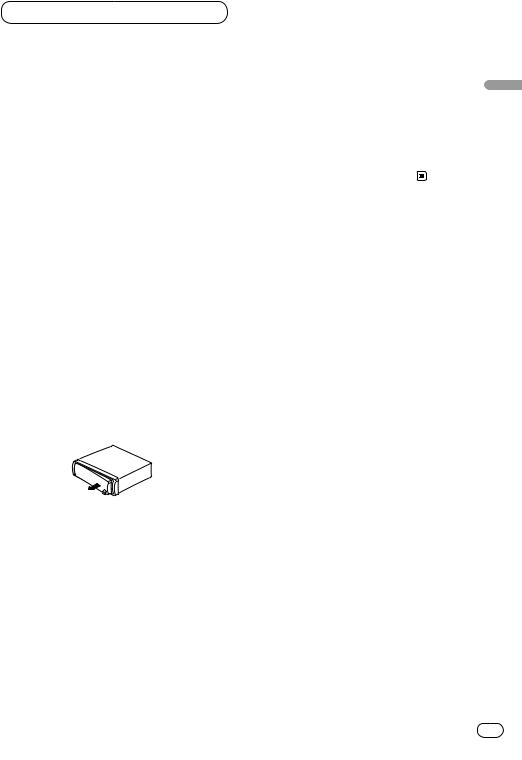
Before You Start
Protecting your unit from theft
The front panel can be detached from the head unit to discourage theft.
 Important
Important
•Never use force or grip the display and the buttons tightly when removing or attaching.
•Avoid subjecting the front panel to excessive shocks.
•Keep the front panel out of direct sunlight and high temperatures.
Removing the front panel
1Press DETACH to release the front panel.
Press DETACH and the right side of the panel is released from the head unit.
2Grab the front panel and remove.
Grab the right side of the front panel and pull away to the left. The front panel will be detached from the head unit.
Attaching the front panel |
English |
||
1 |
Place the front panel flat against the head |
||
|
|||
unit. |
|
||
2 |
Press the front panel into the face of the |
|
|
head unit until it is firmly seated. |
|
||
|
|
Español |
|
Italiano Français Deutsch
Nederlands
En 4
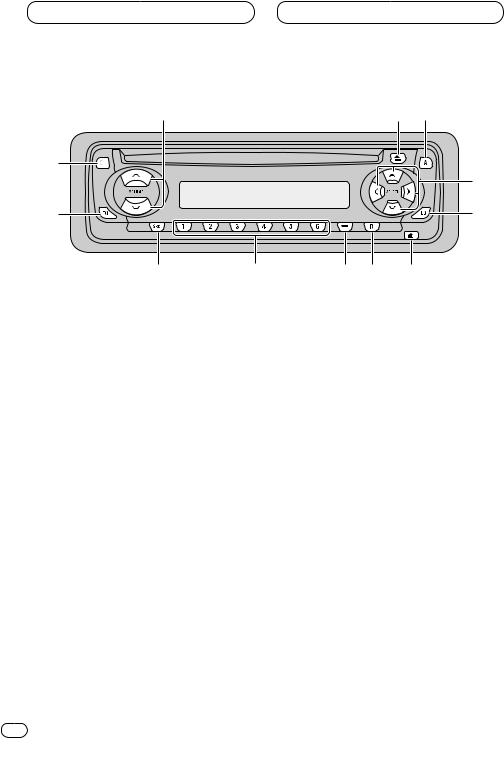
Before You Start
1
4
5
8 9
What’s what
1VOLUME button
Press to increase or decrease the volume.
2CD EJECT button
Press to eject a CD from your built-in CD player.
3AUDIO button
Press to select various sound quality controls.
4CLOCK button
Press to switch clock display on or off.
5EQ button
Press to select various equalizer curves.
65/∞/2/3 buttons
Press to do manual seek tuning, fast forward, reverse and track search controls. Also used for controlling functions.
2 3
6
7
0 - =
7LOUDNESS button
Press to switch loudness function on or off.
8SOURCE button
This unit is switched on by selecting a source. Press to cycle through all of the available sources.
91–6 (PRESET TUNING) buttons
Press for preset tuning.
0 LOCAL/BSM button
-BAND button
Press to select among three FM and one AM band and cancel the control mode of functions.
=DETACH button
Press to remove the front panel from the head unit. 
5 En
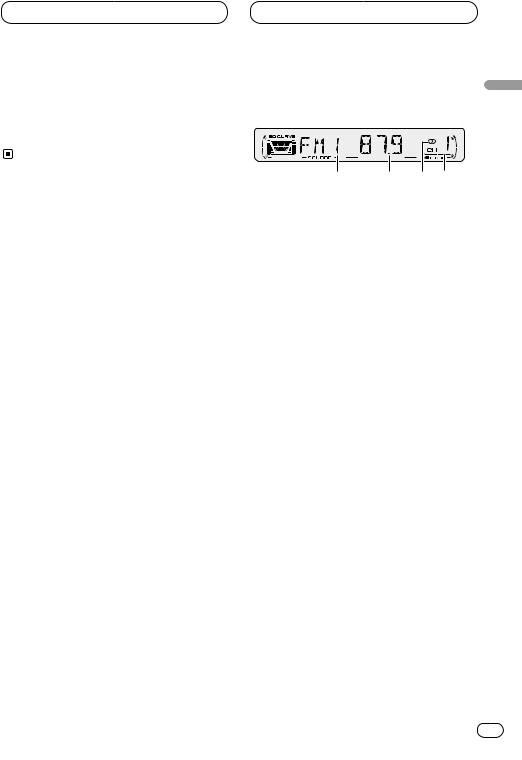
Power ON/OFF |
Tuner |
Turning the unit on
Press SOURCE to turn the unit on.
When you select a source the unit is turned on.
Selecting a source
You can select a source you want to listen to. To switch to the built-in CD player, load a disc in this unit (refer to page 8).
Press SOURCE to select a source.
Press SOURCE repeatedly to switch between the following sources:
Built-in CD player—Tuner
 Notes
Notes
•When no disc is set in this product, built-in CD player source will not change.
•When this unit’s blue/white lead is connected to the car’s auto-antenna relay control terminal, the car’s antenna extends when this unit’s source is switched on. To retract the antenna, switch the source off. 
Listening to the radio
12 3 4
1 BAND indicator
Shows which band the radio is tuned to, AM or FM.
2FREQUENCY indicator
Shows to which frequency the tuner is tuned.
3STEREO ( ) indicator
Shows that the frequency selected is being broadcast in stereo.
4PRESET NUMBER indicator
Shows what preset has been selected.
English
Español
Français Deutsch
Turning the unit off
Press SOURCE and hold for at least one second to turn the unit off. 
Italiano
Nederlands
En 6

Tuner
1Press SOURCE to select the tuner.
2Use VOLUME to adjust the sound level.
When you press VOLUME up/+, the volume is raised and when pressed down/–, the volume is lowered.
3Press BAND to select a band.
Press BAND until the desired band is displayed,
FM1, FM2, FM3 for FM or AM.
4To perform manual tuning, press 2 or 3 with quick presses.
The frequencies move up or down step by step.
5To perform seek tuning, press and hold 2 or 3 for about one second and release.
The tuner will scan the frequencies until a broadcast strong enough for good reception is found.
• You can cancel seek tuning by pressing either 2 or 3 with a quick press.
• If you press and hold 2 or 3 you can skip broadcasting stations. Seek tuning starts as soon as you release the buttons.
 Note
Note
•When the frequency selected is being broadcast in stereo the STEREO ( ) indicator will light. 
Storing and recalling broadcast frequencies
If you press any of the PRESET TUNING buttons you can easily store up to six broadcast frequencies for later recall with the touch of a button.
When you find a frequency that you want to store in memory press a PRESET TUNING button and hold until the preset number stops flashing.
The number you have pressed will flash in the PRESET NUMBER indicator and then remain lit. The selected radio station frequency has been stored in memory.
The next time you press the same PRESET TUNING button the radio station frequency is recalled from memory.
 Notes
Notes
•Up to 18 FM stations, 6 for each of the three FM bands, and 6 AM stations can be stored in memory.
•You can also use 5 and ∞ to recall radio station frequencies assigned to PRESET TUNING buttons. 
7 En
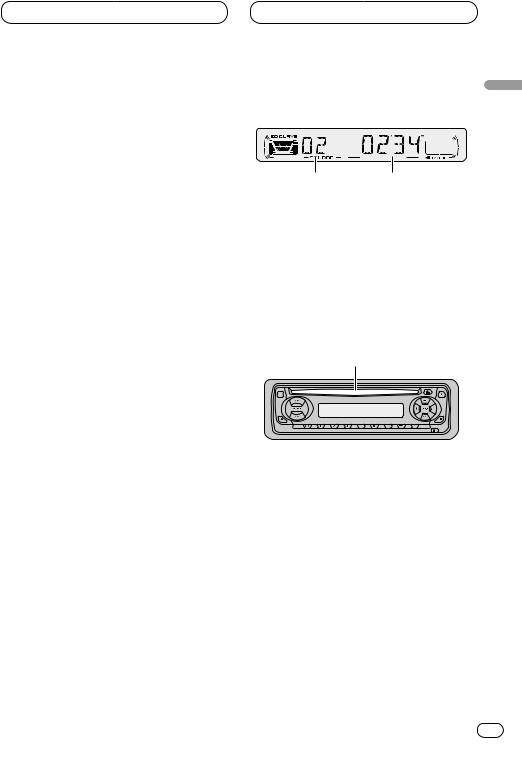
Tuner
Tuning in strong signals
Local seek tuning lets you tune in only those radio stations with sufficiently strong signals for good reception.
1Press LOCAL/BSM to turn local seek tuning on.
Local seek sensitivity (LOC) appears in the display.
2When you want to return to normal seek tuning, press LOCAL/BSM to turn local seek tuning off. 
Storing the strongest broadcast frequencies
BSM (best stations memory) lets you automatically store the six strongest broadcast frequencies under PRESET TUNING buttons 1–6 and once stored there you can tune in to those frequencies with the touch of a button.
Press and hold LOCAL/BSM for about two seconds to turn BSM on.
BSM begins to flash. While BSM is flashing the six strongest broadcast frequencies will be stored under PRESET TUNING buttons in order of their signal strength. When finished, BSM stops flashing.
• To cancel the storage process, press
LOCAL/BSM.
 Note
Note
•Storing broadcast frequencies with BSM may replace broadcast frequencies you have saved using PRESET TUNING. 
Built-in CD player
Playing a CD
12
1 TRACK NUMBER indicator
Shows the track currently playing.
2PLAY TIME indicator
Shows the elapsed playing time of the current track.
1 Insert a CD into the CD loading slot.
Playback will automatically start.
CD loading slot
• You can eject a CD by pressing CD EJECT.
2After a CD has been inserted, press SOURCE to select the built-in CD player.
3Use VOLUME to adjust the sound level.
When you press VOLUME up/+, the volume is raised and when pressed down/–, the volume is lowered.
English
Español
Italiano Français Deutsch
Nederlands
En 8

Built-in CD player
4To perform fast forward or reverse, press and hold 2 or 3.
5To skip back or forward to another track, press 2 or 3.
Pressing 3 skips to the start of the next track. Pressing 2 once skips to the start of the current track. Pressing again will skip to the previous track.
 Notes
Notes
•The built-in CD player plays one, standard, 12-cm or 8-cm (single) CD at a time. Do not use an adapter when playing 8-cm CDs.
•Do not insert anything other than a CD into the CD loading slot.
•If you cannot insert a disc completely or if after you insert a disc the disc does not play, check that the label side of the disc is up. Press CD EJECT to eject the disc, and check the disc for damage before inserting the disc again.
•If the built-in CD player does not operate properly, an error message such as ERR 14 may be displayed. Refer to Understanding built-in CD player error messages on page 15. 
Playing tracks in a random order
Random play lets you play back tracks on the CD in a random order.
1 Press 4 to turn random play on.
RDM appears in the display. Tracks will play in a random order.
2 Press 4 to turn random play off.
Tracks will continue to play in order. 
Repeating play
Repeat play lets you hear the same track over again.
1 Press 5 to turn repeat play on.
RPT appears in the display. The track presently playing will play and then repeat.
2 Press 5 to turn repeat play off.
The track presently playing will continue to play and then play the next track.
 Note
Note
• If you perform track search or fast forward/reverse, repeat play is automatically cancelled. 
Pausing CD playback
Pause lets you temporarily stop playback of the CD.
1 Press 6 to turn pause on.
PAUSE appears in the display. Play of the current track pauses.
2 Press 6 to turn pause off.
Play will resume at the same point that you turned pause on. 
9 En

Audio Adjustments
Introduction of audio adjustments
1 2
1AUDIO display
Shows the audio adjustments status.
2LOUD indicator
Appears in the display when loudness is turned on.
Press AUDIO to display the audio function names.
Press AUDIO repeatedly to switch between the following audio functions:
FADER (balance adjustment)—EQ (equalizer)— LOUD (loudness)—FIE (front image enhancer)—SLA (source level adjustment)
•When selecting the FM tuner as the source, you cannot switch to SLA.
•To return to the display of each source, press
BAND.
 Note
Note
•If you do not operate the audio function within about 30 seconds, the display is automatically returned to the source display. 
Using balance adjustment
You can select a fader/balance setting that provides an ideal listening environment in all occupied seats.
1 Press AUDIO to select FADER.
Press AUDIO until FADER appears in the display.
• If the balance setting has been previously adjusted, BAL will be displayed.
2Press 5 or ∞ to adjust front/rear speaker balance.
Each press of 5 or ∞ moves the front/rear speaker balance towards the front or the rear.
• F15 – R15 is displayed as the front/rear speaker balance moves from front to rear.
• 0 is the proper setting when only two speakers are used.
3Press 2 or 3 to adjust left/right speaker balance.
When you press 2 or 3, BAL:0 is displayed. Each press of 2 or 3 moves the left/right speaker balance towards the left or the right.
• BAL:L9 – BAL:R9 is displayed as the left/right speaker balance moves from left to right. 
English
Español
Italiano Français Deutsch
Nederlands
En 10

Audio Adjustments
Using the equalizer
The equalizer lets you adjust the equalization to match car interior acoustic characteristics as desired.
Recalling equalizer curves
There are six stored equalizer curves which you can easily recall at any time. Here is a list of the equalizer curves:
Display |
Equalizer curve |
|
|
SBASS |
Super bass |
|
|
PWRFL |
Powerful |
|
|
NTRL |
Natural |
|
|
VOCAL |
Vocal |
|
|
CSTM |
Custom |
|
|
FLAT |
Flat |
|
|
•CSTM is an adjusted equalizer curve that you create.
•When FLAT is selected no supplement or correction is made to the sound. This is useful to check the effect of the equalizer curves by switching alternatively between FLAT and a set equalizer curve.
Press EQ to select the equalizer.
• If the equalizer has been previously set to an equalizer curve other than PWRFL then the title of that previously selected equalizer curve will be displayed, such as SBASS, NTRL, VOCAL,
CSTM, or FLAT. 
Adjusting equalizer curves
You can adjust the currently selected equalizer curve setting as desired. Adjusted equalizer curve settings are memorized in CSTM.
1Press AUDIO to select the equalizer mode.
Press AUDIO until EQ appears in the display.
2Select the band you want to adjust with
2/3.
L (low) —M (mid) —H (high)
3 Press 5 or ∞ to adjust the equalizer curve.
Each press of 5 or ∞ increases or decreases the equalizer curve respectively.
•+6 – –6 is displayed as the equalizer curve is increased or decreased.
•The actual range of the adjustments are different depending on which equalizer curve is selected.
 Note
Note
•If you make adjustments when a curve other than CSTM is selected, the newly adjusted curve will replace the previous curve. Then a new curve with CSTM appears on the display while selecting the equalizer curve. 
Adjusting loudness
Loudness compensates for deficiencies in the lowand high-sound ranges at low volume.
1 Press AUDIO to select LOUD.
Press AUDIO until LOUD appears in the display.
11 En
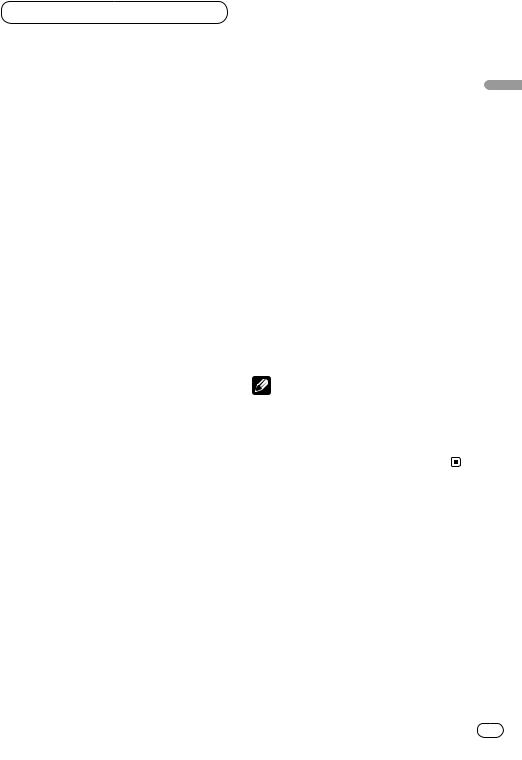
Audio Adjustments
2Select LOUD on or off with 5/∞.
3Select the desired level with 2/3.
LOW (low) —MID (mid) —HI (high)
 Note
Note
•You can also switch LOUD on or off by pressing the LOUDNESS. 
Front image enhancer (FIE)
The F.I.E. (Front Image Enhancer) function is a simple method of enhancing front imaging by cutting midand high-range frequency output from the rear speakers, limiting their output to low-range frequencies. You can select the frequency you want to cut.
 Precaution
Precaution
•When the F.I.E. function is deactivated, the rear speakers output sound of all frequencies, not just bass sounds. Reduce the volume before disengaging F.I.E. to prevent a sudden increase in volume.
1 Press AUDIO to select FIE.
Press AUDIO until FIE appears in the display.
2Select FIE on or off with 5/∞.
3Select the desired frequency with 2/3.
100—160—250 (Hz)
 Notes
Notes
•After switching the F.I.E. function ON, select the Fader/Balance mode in the Audio Menu, and adjust front and rear speaker volume levels until they are balanced.
•Switch the F.I.E. function OFF when using a 2- speaker system. 
Adjusting source levels
SLA (Source level adjustment) lets you adjust |
English |
|
|
the volume level of each source to prevent radi- |
|
cal changes in volume when switching between |
|
sources. |
|
•Settings are based on the volume level of the FM tuner, which remains unchanged.
1 |
Compare the FM tuner volume level with |
Español |
|
||
the level of the source you wish to adjust. |
|
|
2 |
Press AUDIO to select SLA. |
|
Press AUDIO until SLA appears in the display.
3 Press 5 or ∞ to adjust the source volume. |
Deutsch |
|||
Each press of 5 or ∞ increases or decreases |
||||
|
||||
the source volume. |
|
|||
• SLA +4 – SLA –4 is displayed as the source |
|
|||
volume is increased or decreased. |
|
|||
|
|
Notes |
|
|
|
|
|
||
|
|
|
|
|
• Since the FM tuner volume is the control, it is |
Français |
|||
• The AM tuner volume level can also be |
||||
|
not possible to apply source level adjustments |
|
||
|
to the FM tuner. |
|
||
|
adjusted with source level adjustments. |
|
||
|
|
|
Italiano |
|
Nederlands
En 12
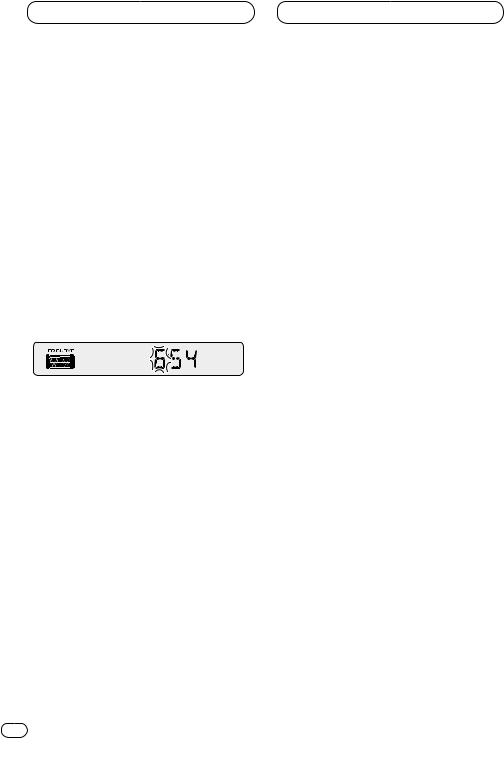
Other Functions
Setting the time
This is used to set the time on the unit’s clock display.
1Press SOURCE and hold until the unit turns off.
2Press AUDIO and hold until TIME (12:00) appears in the display.
3Select the portion of the time display you wish to set with 2/3.
Pressing 2/3 will select a portion of the clock display:
HOUR—MINUTE
As you select portions of the clock display the portion selected will blink.
4 Select the correct time with 5/∞.
Pressing 5 will increase the selected hour or minute. Pressing ∞ will decrease the selected hour or minute.
•To cancel time settings, press BAND.
•You can also cancel time settings by holding down AUDIO until the unit turns off. 
Setting the time display on or off
You can turn the time display on even when the sources are off.
Press CLOCK to select the time display.
Each press of CLOCK turns time display on or off.
• The time display disappears temporarily when you perform other operations, but the time indication is displayed again after 25 seconds. 
13 En
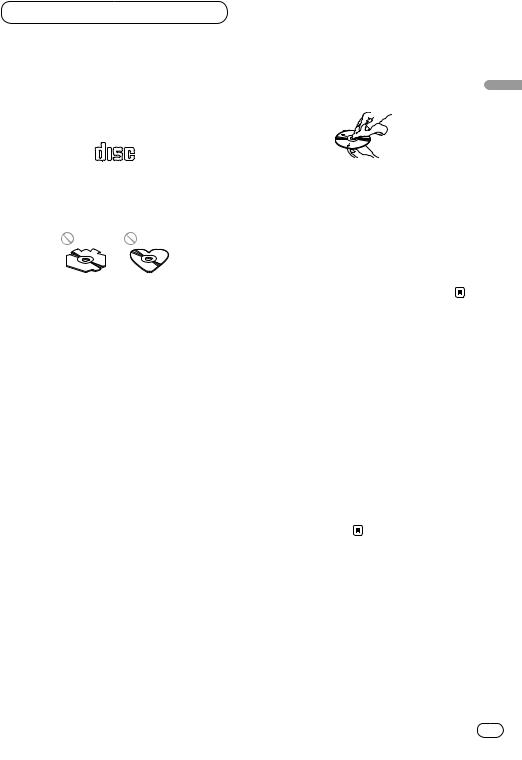
Additional Information
CD player and care
•Use only CDs that have the Compact Disc Digital Audio marks as shown below.
COMPACT
DIGITAL AUDIO
•Use only normal, round CDs. If you insert irregular, non-round, shaped CDs they may jam in the CD player or not play properly.
•Check all CDs for cracks, scratches or warped discs before playing. CDs that have cracks, scratches or are warped may not play properly. Do not use such discs.
•Avoid touching the recorded (non-printed side) surface when handling the disc.
•Store discs in their cases when not in use.
•Keep discs out of direct sunlight and do not expose the discs to high temperatures.
•Do not attach labels, write on or apply chemicals to the surface of the discs.
.
• To clean dirt from a CD, wipe the disc with a |
|
|||
soft cloth outward from the center of the disc. |
English |
|||
|
|
|
||
|
|
|
||
|
|
|
|
|
• If the heater is used in cold weather, moisture |
|
|||
may form on components inside the CD |
Español |
|||
player. Condensation may cause the CD |
||||
|
||||
player to not operate properly. If you think that |
|
|||
condensation is a problem turn off the CD |
|
|||
player for an hour or so to allow the CD player |
|
|||
to dry out and wipe any damp discs with a soft |
|
|||
cloth to remove the moisture. |
|
|||
• Road shocks may interrupt CD playback. |
|
|||
CD-R/CD-RW discs |
Deutsch |
|||
|
||||
• CD-R (CD-Recordable)/CD-RW (CD- |
|
|||
Rewritable) discs recorded on CD-R/CD-RW |
|
|||
units other than a music CD recorder may not |
Français |
|||
play properly on this CD player. |
||||
|
||||
• Music CD-R/CD-RW discs, even recorded on a |
|
|||
music CD recorder, may not play properly on |
|
|||
this CD player due to differing disc character- |
|
|||
istics, scratches or dirt on the disc. Dirt or |
|
|||
condensation on the lens inside this unit may |
|
|||
also prevent playback. |
Italiano |
|||
• Read the precautions with CD-R/CD-RW discs |
||||
|
||||
before using them. |
|
|||
Nederlands
En 14

Additional Information
Understanding built-in CD player error messages
When problems occur during CD play an error message may appear on the display. If an error message appears on the display refer to the table below to see what the problem is and the suggested method of correcting the problem. If the error cannot be corrected, contact your dealer or your nearest Pioneer Service Center.
Message |
Cause |
Action |
|
|
|
ERR 11, 12, 17, |
Dirty disc |
Clean disc. |
30 |
|
|
|
|
|
ERR 11, 12, 17, |
Scratched disc |
Replace disc. |
30 |
|
|
|
|
|
ERR 14 |
Blank disc |
Check the disc. |
|
|
|
ERR 10, 11, 12, |
Electrical or |
Turn the ignition |
14, 17, 30, A0 |
mechanical |
ON and OFF, or |
|
|
switch to a |
|
|
different source, |
|
|
then back to the |
|
|
CD player. |
|
|
|
HEAT |
CD player over- |
Turn off the CD |
|
heated |
player until the |
|
|
CD player cools |
|
|
down. |
|
|
|
15 En
